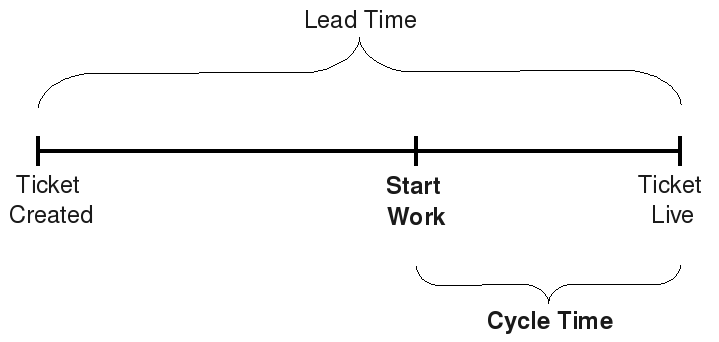Cycle Time and Lead time are two important metrics to track when it comes to project management. When it comes to software development, time is money. Seeing how time is used in development is critical to creating better strategies and more efficient teams. Understanding Cycle Time vs Lead Time in software development is key to unlocking their true potential for improving development efforts.
In modern software production, this means delivering quality products quickly to meet and, where possible, to exceed customer expectations.
What are Cycle Time and Lead Time?
The terms Cycle Time and Lead Time were originally derived from lean manufacturing principles. While both KPIs appear to measure the same thing, they offer insights into development in different ways.
In a broad sense, Lead Time measures how long a given project takes from start to completion. In software development, it covers the time that passes from the start of a project (or when a customer makes a request) to the time when the customer has the product or functionality at their disposal.

Cycle Time on the other hand is a more focused view of how time is used by software teams. In software development, it usually refers to the time taken from the start of work on a project to its completion.
Understanding Cycle Time vs Lead Time
Cycle Time may appear similar to Lead Time, but they provide different insights into development. When weighing the benefits of Cycle Time vs Lead Time, it’s important to understand how these metrics are calculated and how they can be used.
Lead Time Overview
On its own, Lead Time is a high-level metric that gives a top-down view of how time is used in development. It’s a customer-focused metric that essentially reflects how long customers wait for a product or feature to be delivered.
Lead Times are related to Time To Value (TTV), or how long it takes your customers to see their expected returns on investment in your products. Longer Lead Times mean longer TTV, which can have a negative impact on Customer Satisfaction. Long wait times for new products or features contribute to customer frustration, leading them to seek out software providers who can meet their needs faster.
Measuring Lead Time
Measuring Lead Time may seem simple, but in fact, it can differ from team to team. Commonly, the clock on a project’s Lead Time may start once a request is received from a customer and teams commit to the project. The clock is “stopped” once the feature is complete and deployed to the production environment.
How is Lead Time used?
Lead Time can be useful for maintaining a customer-focused view throughout the software development lifecycle. Measuring trends in Lead Time by project can help teams benchmark performance goals and identify inefficiencies in their development.
Lead Time can drag on when routine tasks are commonly stuck. For example, when tasks have been sitting in the backlog or where changes aren’t being pushed forward on features in development. These can be caused by poor planning, poor prioritization of tasks, or difficulties faced within the team. Whatever the causes, these issues can add to Lead Times; bloating budgets, causing delays, and of course, making your customers wait even longer for the features and functionality they need.
Weaknesses of Lead Time
This metric is essentially a zoomed-out view of the development process timeframe. While this is good for offering an overview of areas of the process, from the customer’s request to the delivery of the product, feature, or bug fix, it doesn’t offer much more detail than that. This lack of detail makes it difficult to diagnose problems and thus optimize processes.
The best way to make use of Lead Time is in tandem with other time-based metrics like:
- Cycle Time
- Blocked Time
- Lead Time for changes
Cycle Time Overview
While Cycle Time contributes to Lead Time, it focuses on the software development team’s operations. If teams take longer to complete tasks in a project, final delivery of the feature will also take longer.
Measuring Cycle Time
As mentioned above, Cycle Time typically measures the time it takes for development teams to complete a task or feature, from the start of work to its completion, occasionally exclusive of the deployment stage. Its main function as an internally facing metric is reflecting team activity. For Agile teams, cycle time is usually measured in days and usually starts when work starts on the project.
While this might seem concrete, how software teams define the “start” of work can vary from company to company. Some teams may choose to include planning and design phases in their Cycle time, while others may focus purely on time in development when code is actively being written and committed. In teams that use Kanban boards, Cycle Time can be measured as the time between a ticket moving from “In progress” to “Done”.
The overall goal is to quantify the time that engineers spend on producing and delivering working products that meet the SLA. Whether your team measures their Cycle Time inclusive of planning and design or not, it’s important that they’re consistent with how they measure it across every project.
How is Cycle Time used?
Offering a more focused look at the development process than Lead Time, Cycle Time can be very useful for further isolating areas of development that can be optimized. Many software engineers and managers may feel that they’re already working as efficiently as possible, but without quantifiable KPIs to compare their performance historically, it’s difficult to identify areas for improvement.
Tracking Cycle Time provides greater forecasting ability. This helps teams to better estimate the time needed to implement new features or functionalities. Additionally, average Cycle Time can be used to benchmark performance, giving teams targets for time spent in development on projects.
Some of the benefits of tracking Cycle Times and acting on the insights they provide include:
- Faster software delivery
- Improved Customer satisfaction
- more efficient development processes
- better team morale
Weaknesses of Cycle Time
Compared to Lead Time, Cycle Time may seem like a better metric of time; however, one of its weaknesses is that it misses out on the non-developer-focused aspects of development. Tracking the time spent collecting requirements or non-coding tasks that contribute to development is also important for understanding the factors that contribute to overall lead times.
While Cycle Time offers a great deal of utility, it can be difficult to see where your development can be improved without a more comprehensive view of the development process. Breaking down Cycle Time even further can help with gaining visibility into the process.
Another limitation some software managers may find is that neither Cycle Time nor Lead Time offers insight into how quickly developers should be working. Instead, these are retroactive metrics that report time as it has been used.
Volatility in Cycle Time and Lead Time
When considering your Cycle and Lead times, it’s important to be mindful of stability vs volatility over time.
When your Cycle Time varies widely from project to project, it suggests that your teams are facing challenges in development and a more thorough investigation is needed to get to the root of the variance. Stable Cycle Times provide better benchmarking and are useful indicators of efficient and smooth development operations.
On the other hand, variation in Lead Times can depend on the rate at which work comes in for teams to deal with. As more requests arrive, the backlog grows. Items that stay in the backlog contribute to longer Lead Times. While there isn’t much that teams can do to control the rate of work items (or requests coming in), they can impose Work in Progress (WIP) limitations to ensure that they aren’t operating beyond capacity.
The aim of any development team should be to maintain reliable development pipelines that ensure steady, high-quality delivery to clients. Focusing efforts on smoothing out Cycle and Lead Time volatility is a good way to support this. This is much simpler if your teams are already measuring these metrics.
Cycle Time and Lead Time are only the beginning
When comparing Cycle Time vs Lead Time, it’s a good idea to use these metrics as indicators of inefficiencies or needs for intervention. That said, neither can provide perfect visibility into development. To really understand the root causes of inefficiencies and blockers, you need to dig deeper.
It’s important to have a wider range of KPIs available. Having the right tools to provide deeper insights into your development can make a huge difference. To learn more about other important software KPIs you should be tracking, check out our article here.
About the author
Alvaro Marinetto
Working as Foreworth’s, Development Director, Alvaro manages the day-to-day activities of the development team. He helps steer the direction of the company’s new feature development as well as their maintenance efforts.
More info →


What do you think? Leave us your comments here!